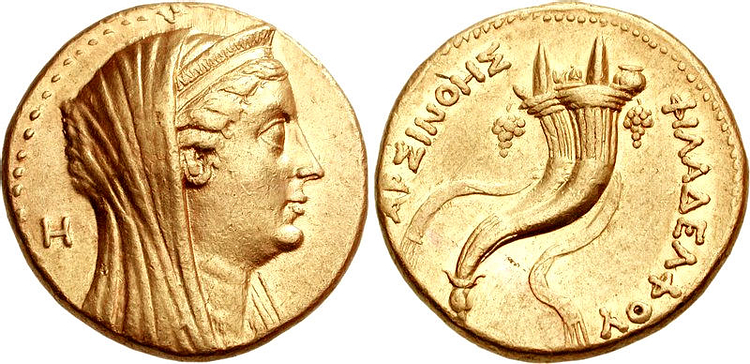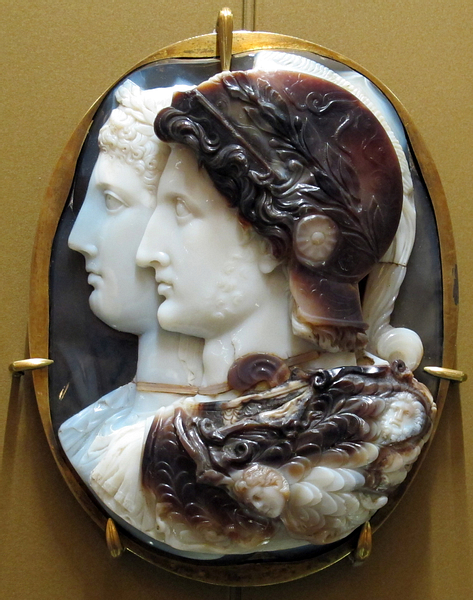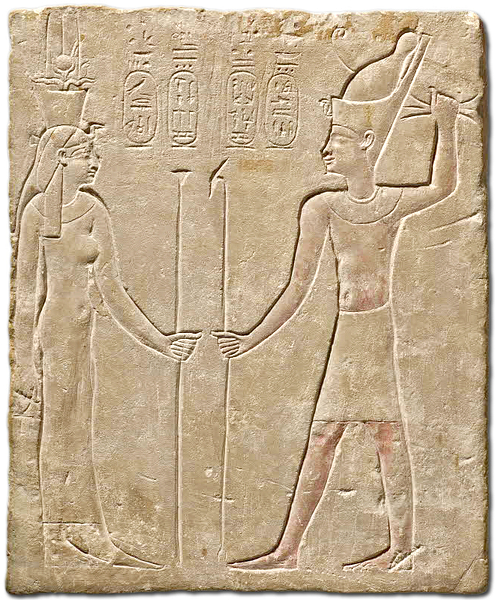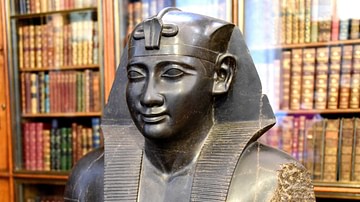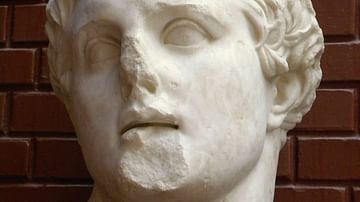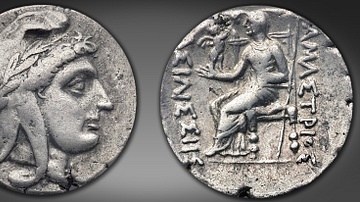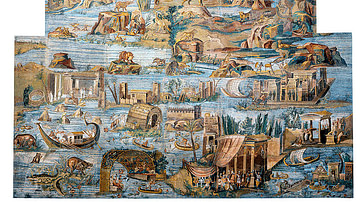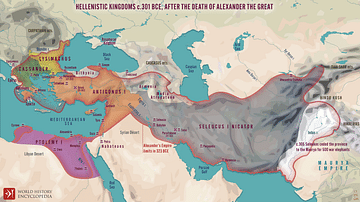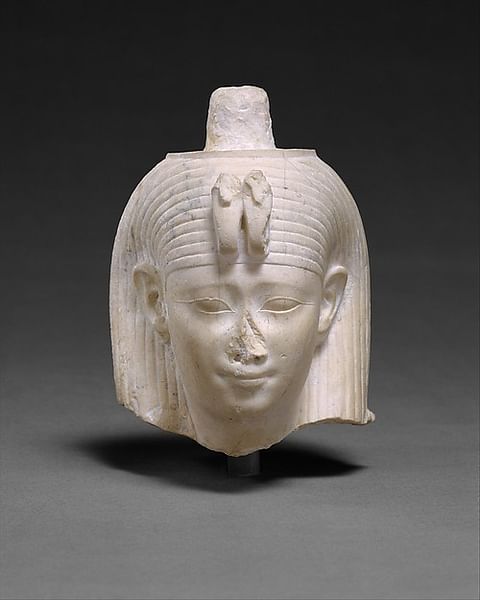
Arsinoe II (l. c. 318/311 - c. 270/268 BCE), daughter of Ptolemy I became one of the most enduring figures of the Lagid or Ptolemaic Dynasty and left an undeniable mark in the historical evidence. She was married three times; first to Alexander the Great's general Lysimachus, then to her half-brother Ptolemy, nicknamed Ceraunus, and finally to his full brother Ptolemy II. She became to model for succeeding Ptolemaic queens, down to Cleopatra VII.
Family
Arsinoe, the eldest daughter of Ptolemy and Berenice, was probably born in the Egyptian capital Memphis somewhere between 318 and 311 BCE. She was named after a Macedonian princess (from a collateral branch descending from Alexander I, r. c. 498-454 BCE), to whom her grandfather Lagus was married. Her father Ptolemy was a childhood friend of Alexander the Great and was appointed as Egyptian governor (satrap) after the latter's death (323 BCE). Ptolemy gradually established his power as dynast and – like the other successors (diadochi) – eventually laid claim to kingship (c. 305/4 BCE). He thus became the founder of the Lagid Dynasty that ruled from Egypt until the death of Cleopatra VII (30 BCE).
Berenice, the mother of Arsinoe, was Ptolemy's fourth wife and had herself been married before to a Macedonian nobleman named Philip. From that previous marriage, she was the mother of Magas and thus the grandmother of Berenice II Euergetis. Nothing is known of Arsinoe's childhood. After her birth, however, Ptolemy I moved to the recently built palace in Alexandria (c. 311/10 BCE), where Arsinoe and her siblings Philotera and Ptolemy II, must have grown up along with the children of their father's other wives, Thais, Artacama, and Eurydice. Like Philip II, Alexander the Great and the other successors, Ptolemy was polygamous.
Queen in Thrace & Macedon
When she was married to King Lysimachus of Thrace (c. 300/299 BCE), Arsinoe cannot have been more than a teenager, yet soon gave birth to three sons, Ptolemy (299/8 BCE), Lysimachus (297/6 BCE) and Philip (294/3 BCE). Lysimachus was in his mid-50s at the time of their wedding. He was a childhood friend of her father and Alexander the Great and had been appointed governor of Thrace (corresponding roughly to the area east of Macedon and south of the Danube). From there he expanded his dominion into Asia Minor, laid claim to kingship (c. 305/4 BCE), and eventually captured Macedon (287 BCE). He was additionally married to an unnamed Persian noblewoman at the mass marriage ceremony at Susa (324 BCE), as well as Nicaea (c. 320/19 BCE) and Amastris (302 BCE).
Lysimachus dotted his kingdom with city foundations named after his family members. Such settlements served economic and military functions, as well as symbolic and ideological purposes. For instance, after his death, Lysimachus was buried in his capital in Thrace, Lysimachaea, at the Lysimachaeum, a temple that still existed some 500 years later. He had received a posthumous cult with a temple, an altar, a cult image and a priest in a city he had settled and named after himself. A city in Bythinia was (re)named in honor of Nicaea (c. 300 BCE), famous for the later Council of Nicaea. Amastris settled a city in her own name on the Paphlagonian coast (c. 295-290 BCE).
Likewise, the Ionian city of Ephesus – the site of the Temple of Artemis at Ephesus, one of the Seven Wonders of the Ancient World – was resettled and renamed Arsinoea in honor of Arsinoe (c. 294-289 BCE). Regal money was issued featuring the veiled head of the city goddess, whose facial features compare well with later coin portraits of Arsinoe. The reverses of the earlier emissions (c. 294-281 BCE) show bow and quiver, or a stag, symbols of Artemis. If we may see Arsinoe herself in the portrait, this coinage would represent one of the earliest depictions of a deified woman. It was, however, Lysimachus rather than Arsinoe who received cultic worship as the city's founding hero during his lifetime – which was revived during the reign of Trajan (104 CE).
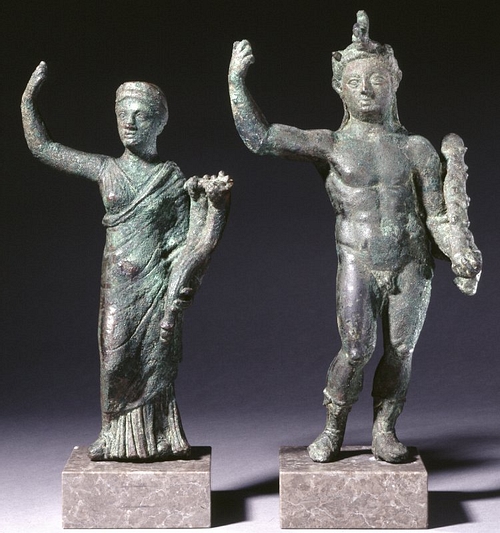
On the island of Delos, a decree (of uncertain date, perhaps c. 290-285 BCE), praises “King Lysimachus and Arsinoe his Queen” for their assurances of goodwill (eunoia) for the good fortune (agathē tychē) of the people. It is important to note that Arsinoe is publicly honored – and not only mentioned by name but also addressed as basilissa (royal woman); none of Lysimachus' other wives are recorded in surviving inscriptions. The decree may furthermore be a testament of her mediation on behalf of the islanders between her father, who controlled Delos, and her husband. To further illustrate her public prominence, Arsinoe's eldest son Ptolemy dedicated a statue of his mother on his father's behalf at Thebes in Boeotia (c. 284-281 BCE).
Shifting Fate & Fortune
Arsinoe was implicated in one of the more remarkable events of the Wars of the Diadochi, which not only lead to the death of Lysimachus' eldest son, Agathocles, but ultimately to Lysimachus' own downfall, too. Arsinoe is said to have manipulated Lysimachus to execute his son with Nicaea because she feared for the lives of her own sons should Agathocles become king after his father's death. However, sources also claim that she had fallen in love with Agathocles but she was spurned. Agathocles was put on trial, found guilty of plotting against his father and executed (c. 285 BCE). When Lysimachus became aware of Arsinoe's machinations, it was too late. His friends either left him – and sought refuge with Seleucus I Nicator in Babylon – or had been murdered in a purge at court.
At the death of Lysimachus, after the Battle of Corupedium (281 BCE) near Sardis, Arsinoe was established in the Ionian city named after her. This may indicate that she had represented her husband's royal power in Asia Minor. She had also gained control over Heraclea after the death of Amastris (c. 284 BCE) and apparently was embroiled in the affairs of Pergamon, a city in Aeolia (western Asia Minor). With the presence of the Seleucid army nearby, the inhabitants of her city opened the gates. Arsinoe was only able to escape by a ruse. She dressed one of her attendants in her royal robes so that while the queen was carried away in the royal litter with a strong guard and slipped out of the town in rags, her servant was killed by one of Seleucus' generals.
Arsinoe then ensconced herself at Cassandrea in the Chalcidian peninsula, together with her children and mercenary troops. Meanwhile, her half-brother Ptolemy nicknamed Ceraunus (“Thunderbolt”), had murdered Seleucus and proclaimed himself king of Thrace and Macedon – leaving the East to Antiochus, the heir of Seleucus. To legitimize his rule – and avoid a violent conflict with Arsinoe – he then offered to marry her and acknowledge her children as his. (He apparently had no children with other women; marriage between half-siblings, of course, was unheard of before.) A wedding ceremony was indeed held in the Macedonian capital Pella in the presence of the army; afterwards festivities were celebrated in Cassandrea on a magnificent, well-nigh divine scale.
Ceraunus then killed Arsinoe's two younger sons; only her eldest, Ptolemy, had been able to escape and take refuge in Illyria. Arsinoe herself was forced out of the city and found sanctuary in Samothrace, the island sacred to the Great Gods Cabeiri, where the famous statue of the Winged Victory (Nike) was later erected. She lived there in exile hoping to see her son gain his father's throne. In gratitude for sheltering her, she later had a rotunda built on the temple enclosure that was the largest round structure of its time. Ceraunus soon enough died at the hands of Gauls crossing the Balkans into Greece (279 BCE), and in the years of ensuing uncertainty, Arsinoe's son Ptolemy was one of the main contenders to the Macedonian throne in (279-277 BCE).
Queenship in Ptolemaic Egypt
Arsinoe eventually returned to Egypt (c. 277-275 BCE) – perhaps with her son Ptolemy in tow. Her brother Ptolemy II had been established by their father as co-ruler to ensure a smooth succession (in 284 BCE) – thereby passing over Ptolemy Ceraunus, his eldest son with his third wife Eurydice. Before the death of Ptolemy I, Ptolemy II had married a daughter of Lysimachus, who was also called Arsinoe. Scraps of evidence point to a conspiracy against the king in which this Arsinoe I was involved. She was removed from court and sent to live in royal comfort at Coptus (modern Qift, Upper Egypt). Whether this conspiracy occurred before the return of Arsinoe II or involved the latter's machinations is unclear. Ptolemy II is credited to have instituted temples and cults of Ptolemy I and Berenice I, the “Savior Gods (Theoi Sotēres)”.
The most dramatic, shocking event then took place when Ptolemy II married his full sister Arsinoe II (c. 275/4 BCE). Their wedding was likened to the “sacred marriage (hieros gamos)” of Zeus and Hera, as well as that of Isis and Osiris. The queen established an annual festival in honor of Adonis at Alexandria, in which Arsinoe was assimilated to Aphrodite and the king to her beloved Adonis, the only mortal of Greek mythology to die and return from the realm of Hades. Moreover, an official cult was created for the “Sibling Gods (Theoi Adelphoi)” (c. 272 BCE). The Ptolemaic admiral who had served as first priest of the royal cult of the Theoi Adelphoi at Alexandria founded a cult of Arsinoe at Cape Zephyrium, near Canopus, in which she was assimilated to Aphrodite as guardian of seafarers. Arsinoe received a lifetime cult under the epithet “Philadelphos (Brother-Loving)” (c. 270 BCE), which persisted for generations. Before her death, Arsinoe nominally became a temple-sharing goddess (synnaos thea) in every temple in Egypt. Across the Ptolemaic sphere of influence, statues were erected in public spaces, temples and priesthoods were established, festivals with processions were celebrated in her honor.
After the sibling-marriage, an Egyptian royal titulature was established for her (274 BCE), which was unparalleled in the Pharaonic period – and was not repeated until Cleopatra VII. While she was still very much alive, Arsinoe II was thus addressed by such titles as “Mistress, Magnanimous,” “Lady of Loveliness, Sweet in Love,” “Beautiful of Appearance, Who Fills the Palace with Her Beauty,” “Who Has Received the Cobras of the Two Crowns,” “Beloved of the Ram, Who Serves the Ram” [of Mendes], “Royal Sister,” “Great Wife of the King [Ptolemy II], His Beloved,” “Queen of the Two Lands,” “Royal Daughter of the King of the Two Lands, Ptolemy [I], the Goddess Who Loves Her Brother.”
Inscriptions survive that attest to Arsinoe's continued prominence at the Alexandrian court in internal and external affairs. She accompanied Ptolemy II to inspect the country's border along the Sinai, visiting important temples on the journey through the Delta – especially at Mendes where the queen was established as high-priestess of the local sacred ram. At Athens, the democratic assembly honored Ptolemy and his sister (not mentioned by name, as that was considered disgraceful) for supporting the “common freedom of the Greeks” against the growing dominance of the Macedonian king Antigonus II Gonatas. Around the same time, the inhabitants of the newly settled colony (polis) of Methana on the Peloponnese dedicated two statues of “King Ptolemy and Arsinoe Philadelphus” to Poseidon on the nearby island of Calauria. The significance of such a statue pair lies in the fact that it illustrates that similar sculptures must have been erected throughout the Ptolemaic sphere of influences.
Representation in Hellenistic Art
Arsinoe II became one of the most revered queens of the Lagid Dynasty, featured on works of art ranging from monumental sculpture and temple relief scenes to miniature coins and engraved gems. Indeed, it is not an exaggeration to state that Arsinoe must have been present everywhere for centuries beyond her death. That prominence alone is a testament to her exemplary role in shaping Hellenistic queenship.
The sibling joint-rule, to be sure, presented Arsinoe II and Ptolemy II as equals. Even though they never had children (and may never have intended to – as Ptolemy II maintained several mistresses), they reigned together as divine sovereigns over the Ptolemaic kingdom and its sphere of influence – stretching from Egypt and the Libyan coast to parts of the Levant and Asia Minor into the Aegean and the Black Sea.
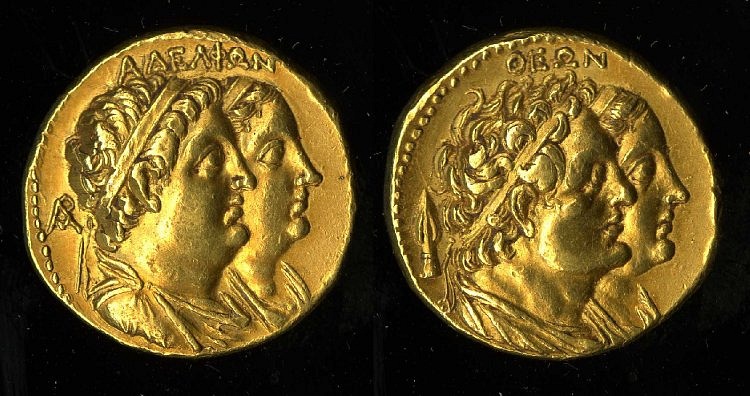
A limestone relief scene from the Chapel of Ptolemy II at Tanis (modern San el-Hagar) that in the Nile Delta portrays the royal couple facing each other perfectly illustrates their parity. The king stands on what in Egyptian canon is the mortal side of the image, wearing the Double Crown of Egypt (pschent), and holding a waz-scepter in his right hand and brandishing a thunderbolt in his upraised left hand. The latter attribute does not belong to Pharaonic iconography but derives from the imagery of Zeus and Alexander the Great, and represents him as hardly a normal mortal. Ptolemy II is identified by his hieroglyphic cartouches with the throne name “wśr-kȝ-n-Ra mrỉ-Ỉmn” (Strong Ka of Ra, Beloved of Amun).
For her part, Arsinoe II stands on the divine side, identified by her hieroglyphic cartouches as “ẖnm.t-ỉb-nśw mrỉ.t-nṯr.w” (Who Unites her Heart with the King, Beloved of the Gods). She holds a papyrus-scepter in one hand and the ankh sign, denoting her immortality, in the other. The queen wears a long sheath dress and collar, a vulture cap over a long wig, and a composite crown that was specially designed for her. It consists of the Red Crown of Lower Egypt (deshret) adorned with two tall feathers (shuty) with level spiraling ram horns surmounted by lyre-shaped cow horns enclosing the sun disc, and an upright cobra (uraeus) in front. The crown of Arsinoe assimilates her with the divine consort of the king and identifies her with Mut-Hathor.
Arsinoe's divinity was also celebrated with cult festivals during which gilded silver or faience wine vases (oenochoae) were used to pour wine. They show the queen in the guise of Agathe Tyche (the personification of good fortune) holding a double cornucopia (dikeras) in one hand and pouring a wine libations on an altar with the other. The dikeras, incidentally, was a double horn of plenty specially created for Arsinoe II and subsequently appropriated by Cleopatra VII. The attribute features prominently on the reverse of the queen's octadrachms (above).
On the masterful double portrait of the so-called Gonzaga Cameo (above), the king's crested helmet is bound with a laurel wreath and decorated with a winged serpent (uraeus); his bust is draped with a scaly fleece (aegis) decorated with the head of Medusa and Phobos (the personification of fear). The queen's veiled head is wreathed with an ear of grain, associating her with natural fertility. The royal couple is thus portrayed as Olympian sovereigns. The sardonyx cameo is named after Renaissance dukes of Mantua and is a miniature masterpiece of Hellenistic art.
Two chief types of coins, or rather golden medallions, were issued that feature her portrait. On one Ptolemy I and Berenice I are featured on the obverse and their children Ptolemy II and Arsinoe II on the reverse – expressing the dynastic lineage descending from both sides from Lagus and Arsinoe. The other coin type, which became one of the most enduring among Ptolemaic coinage, Arsinoe is portrayed alone on the obverse. Her attributes – veil, crown, lotus-tipped scepter, and ram's horn around the ear – symbolize her status as divine consort of the king and of Zeus-Ammon – and thus identifies her as Hera-Dione.
Death & Aftermath
Arsinoe II was not yet 50 years old when she died – although, admittedly the date of her death is a matter of some scholarly dispute (270 or 268 BCE). The poet Callimachus, who would later compose the Coma Berenices, honored the queen's earthly passing with a hymn describing her apotheosis as she passes beyond the full moon to her place in the heavens beneath the Big Dipper while the whole population cries lamentations.
Not long after the time of her death, her brother appointed a joint ruler by the name of Ptolemy “the son” (r. 267-259 BCE). The particular choice of words indicates that the joint ruler cannot be the later Ptolemy III, but someone who was not the biological son of Ptolemy II. The most obvious candidate must be Arsinoe's eldest son, Ptolemy – meaning that at the end of her life she must have finally succeeded in establishing him as a successor to a throne, though not of Macedon or Thrace, but of the Ptolemaic Kingdom. Her son eventually had a fallout with his uncle and claimed kingship in Telmessus (c. 258/6-240 BCE), a city in Lycia (southwest Anatolia).
Ancient authors rarely provide more than basic biographical information about royal women – with the notable exception of Olympias and Cleopatra. The influence at the Alexandrian court of Arsinoe's mother Berenice was noted – but nothing more. Arsinoe's prominence at the court of Lysimachus may not have been exceptional among Hellenistic royal women; it may be mere happenstance in the transmission of the evidence that we know more about her than contemporary queens – or perhaps it is due to her subsequent career.
When she did return to Egypt, she came to set a precedent for female sovereignty that would change the position of Hellenistic queenship in Egypt and beyond. Cities were (re)founded in her honor, she was mentioned by name and title in public decrees, coins portrayed her as a goddess, cults and festivals were founded for her worship, and statues were erected for her, not only in Egypt but throughout the Ptolemaic sphere of influence. When Cleopatra VII came to the throne over 200 years later, her role model can truly be said to have been Arsinoe II.
An earlier version of this article was first published on AncientWorldMagazine.com.
